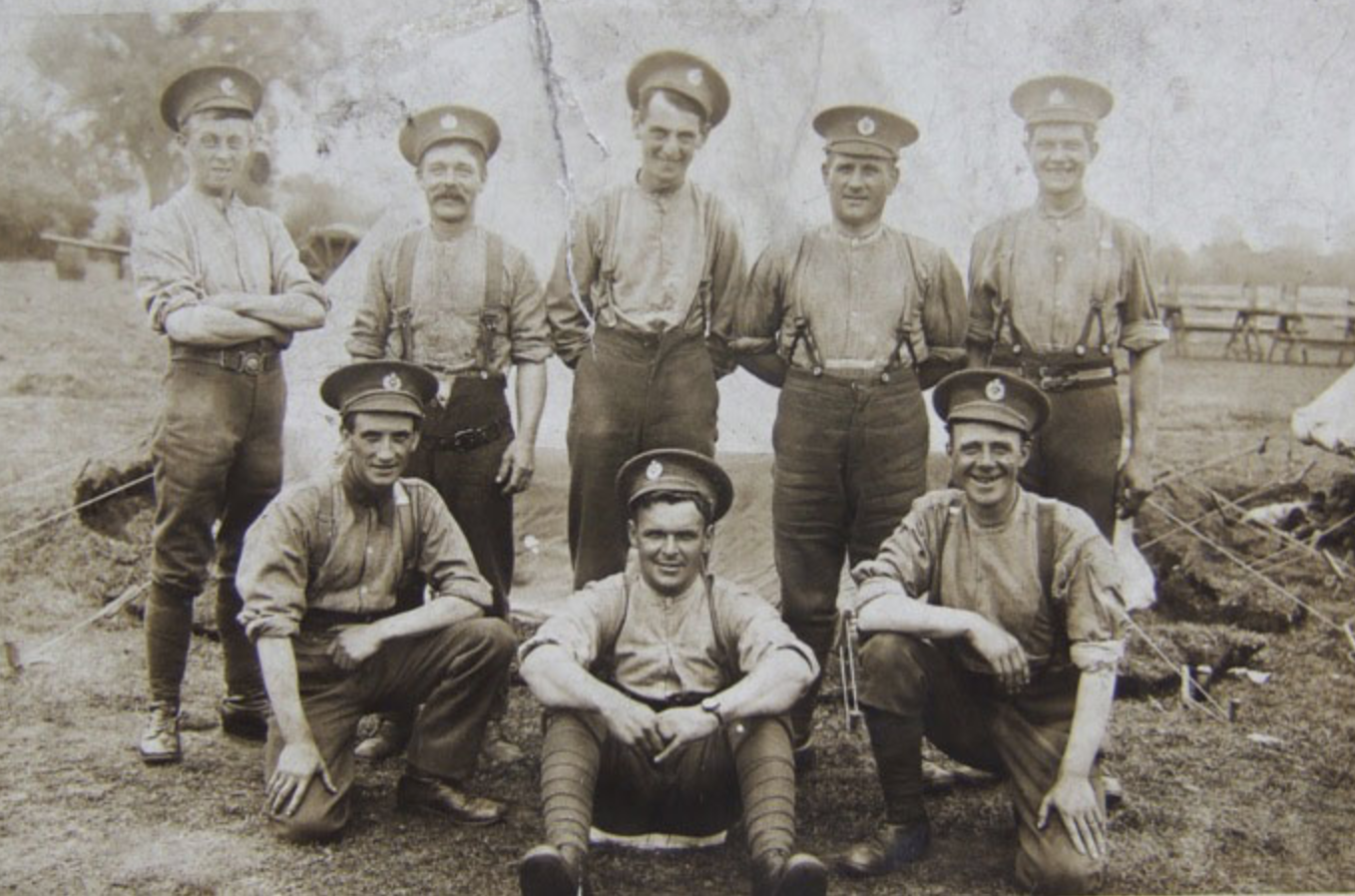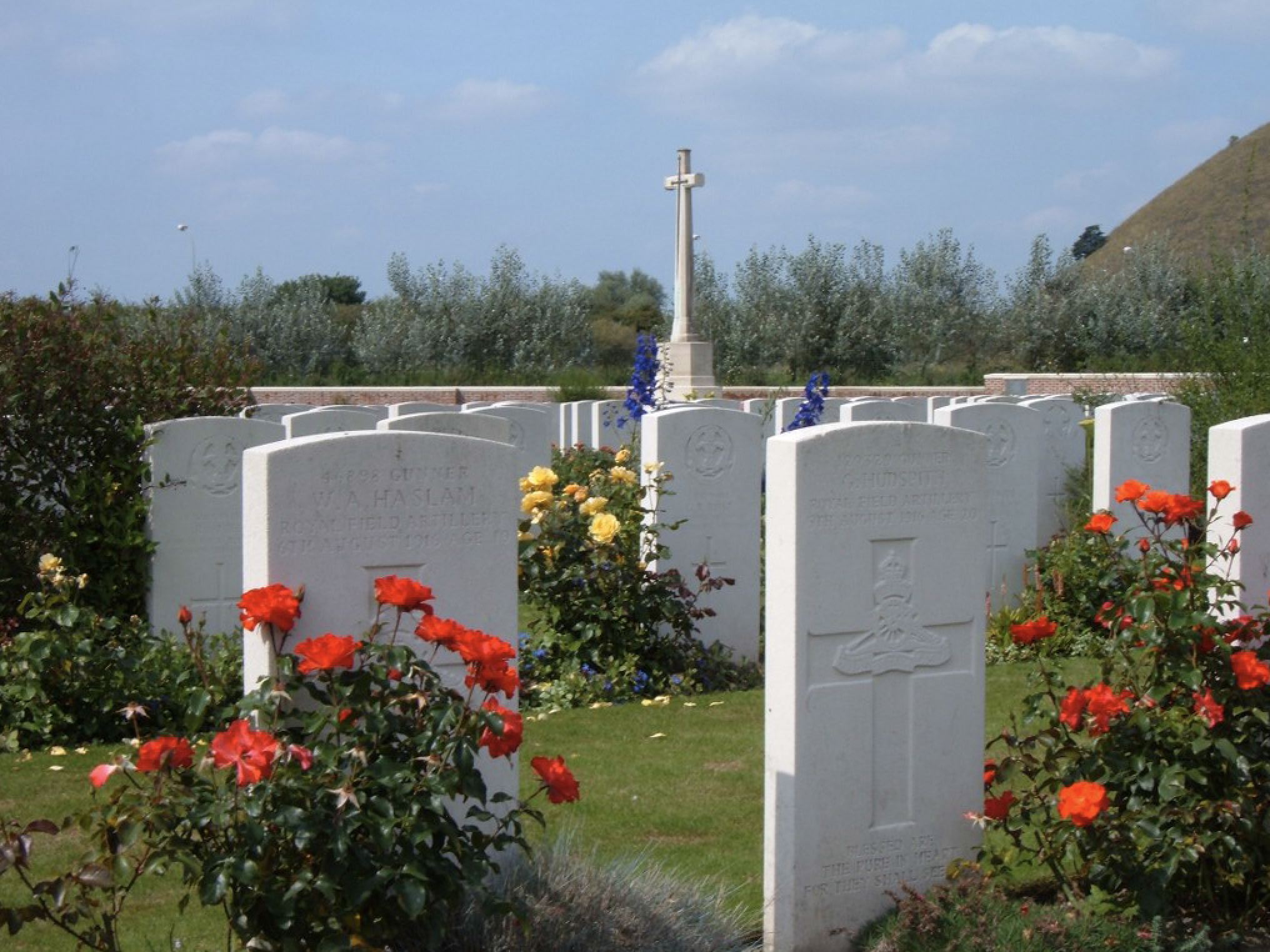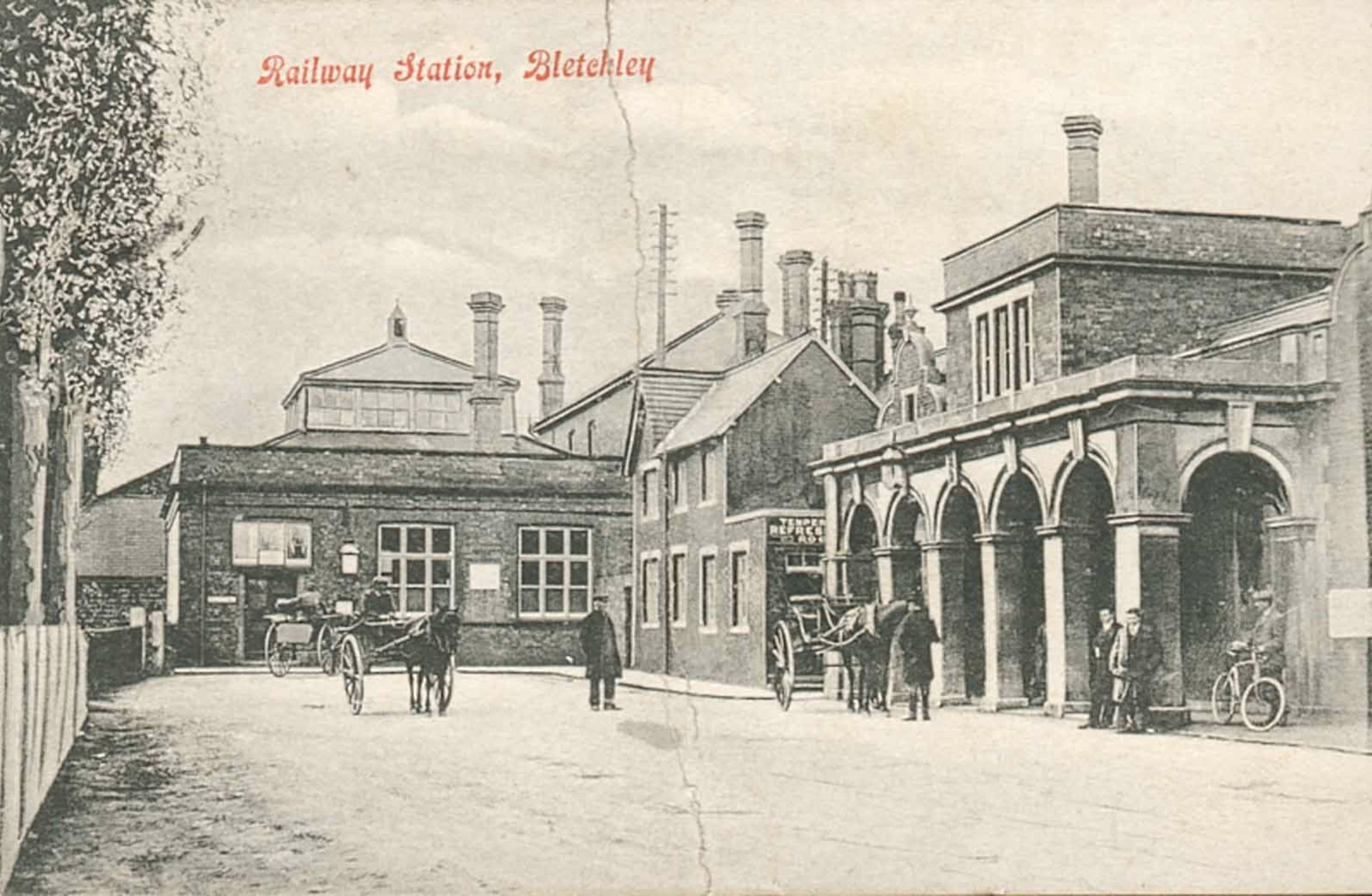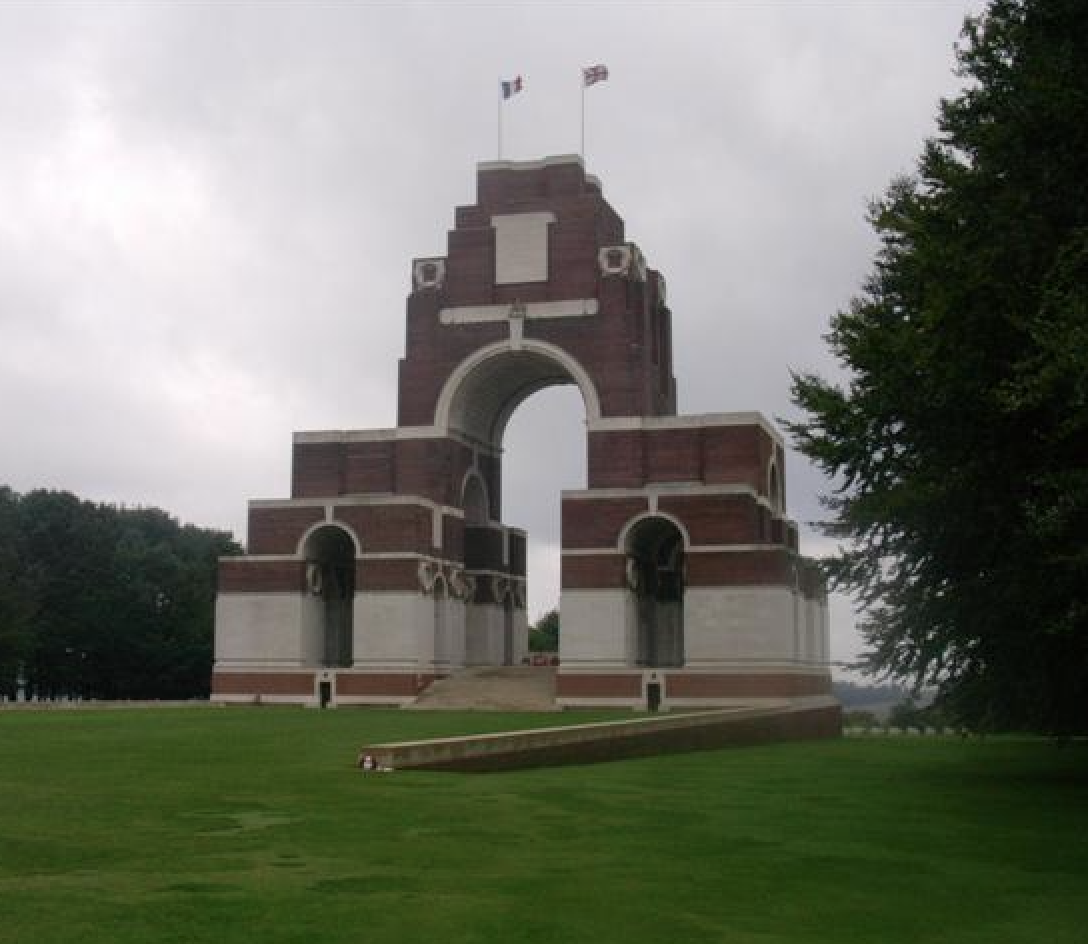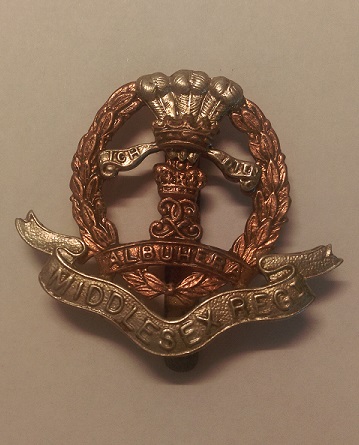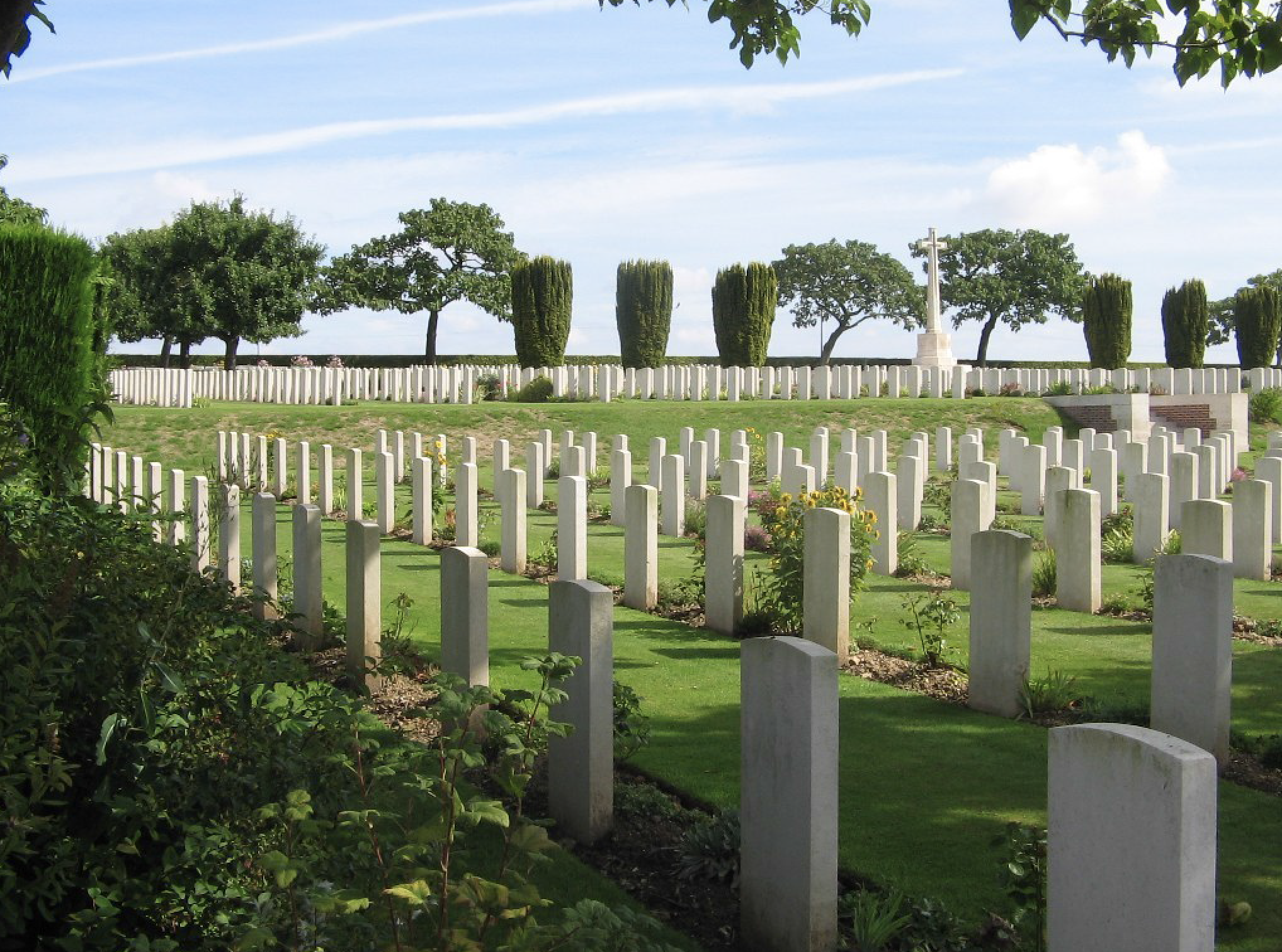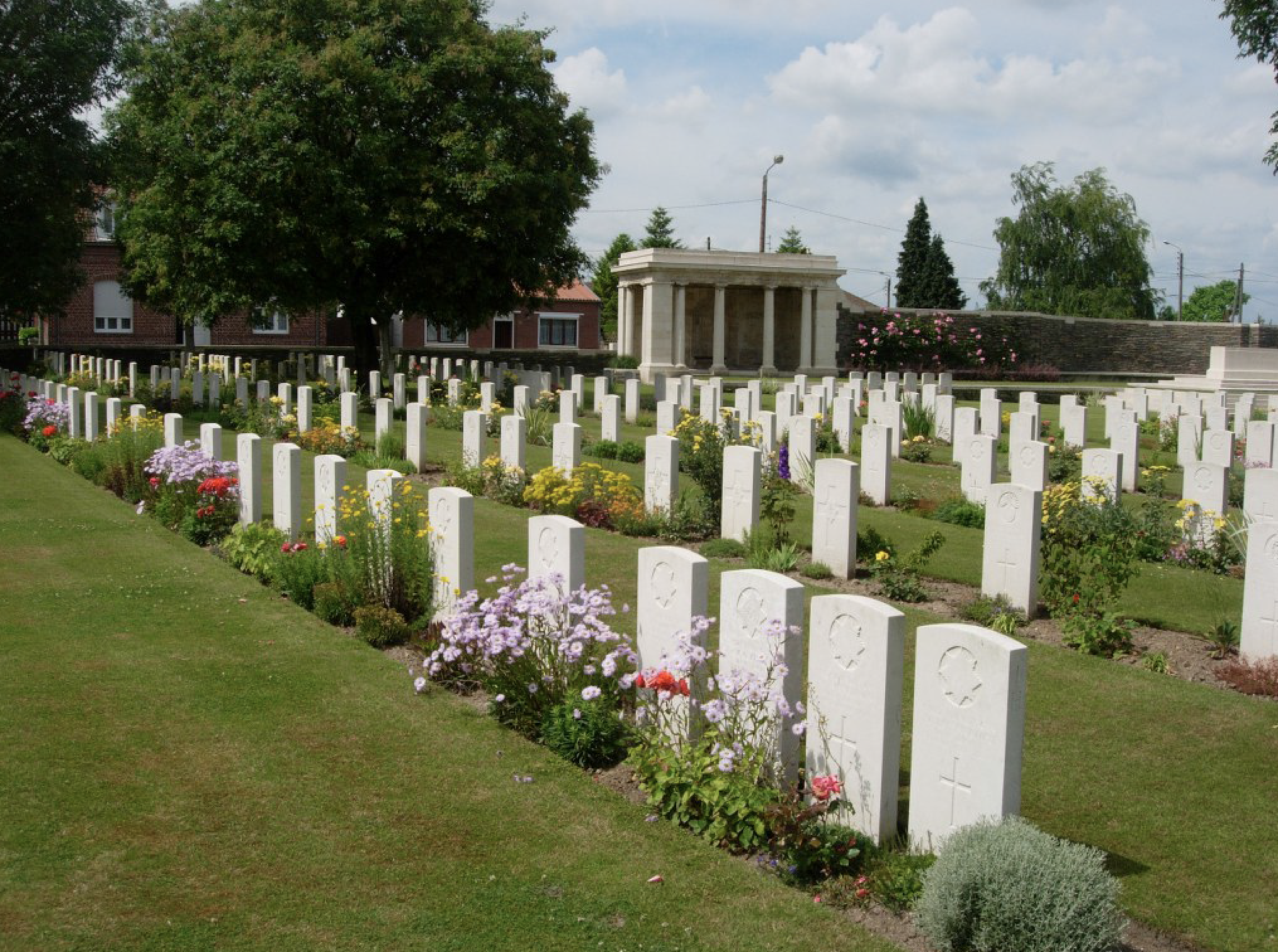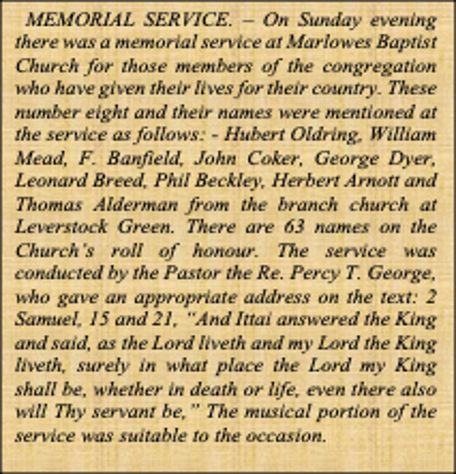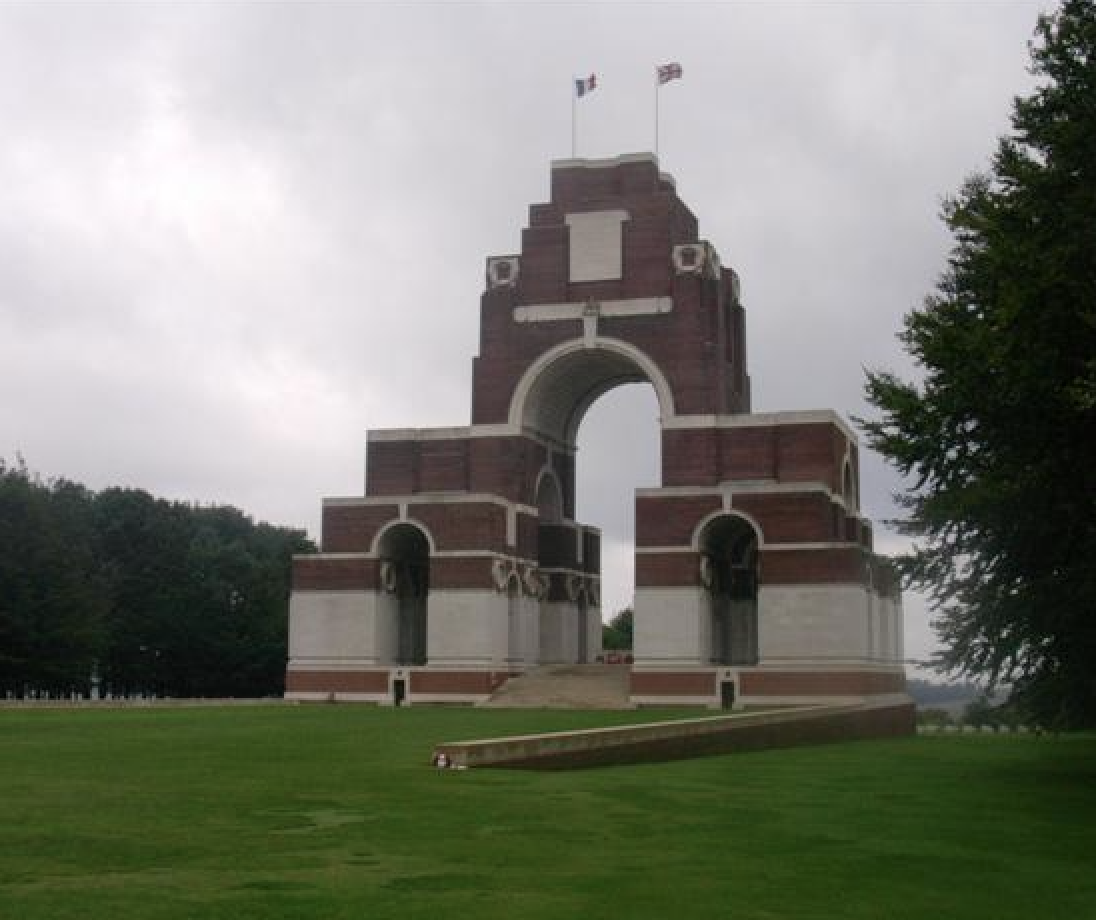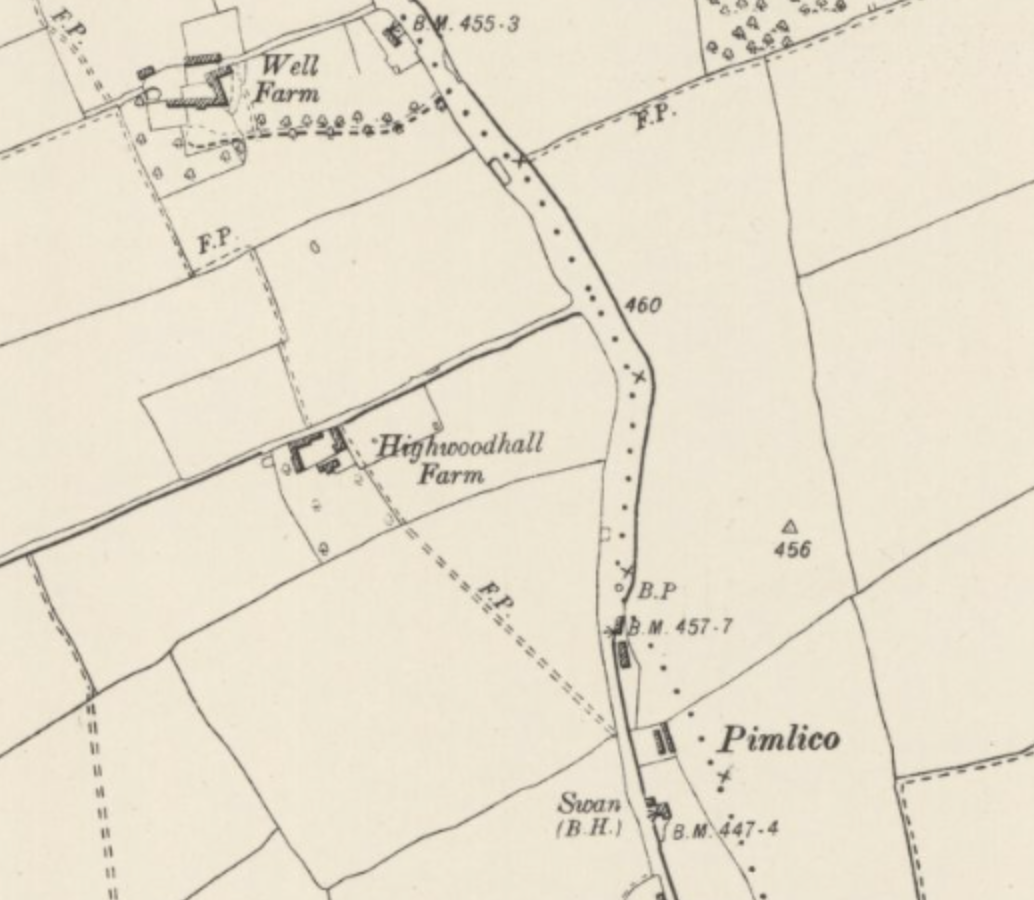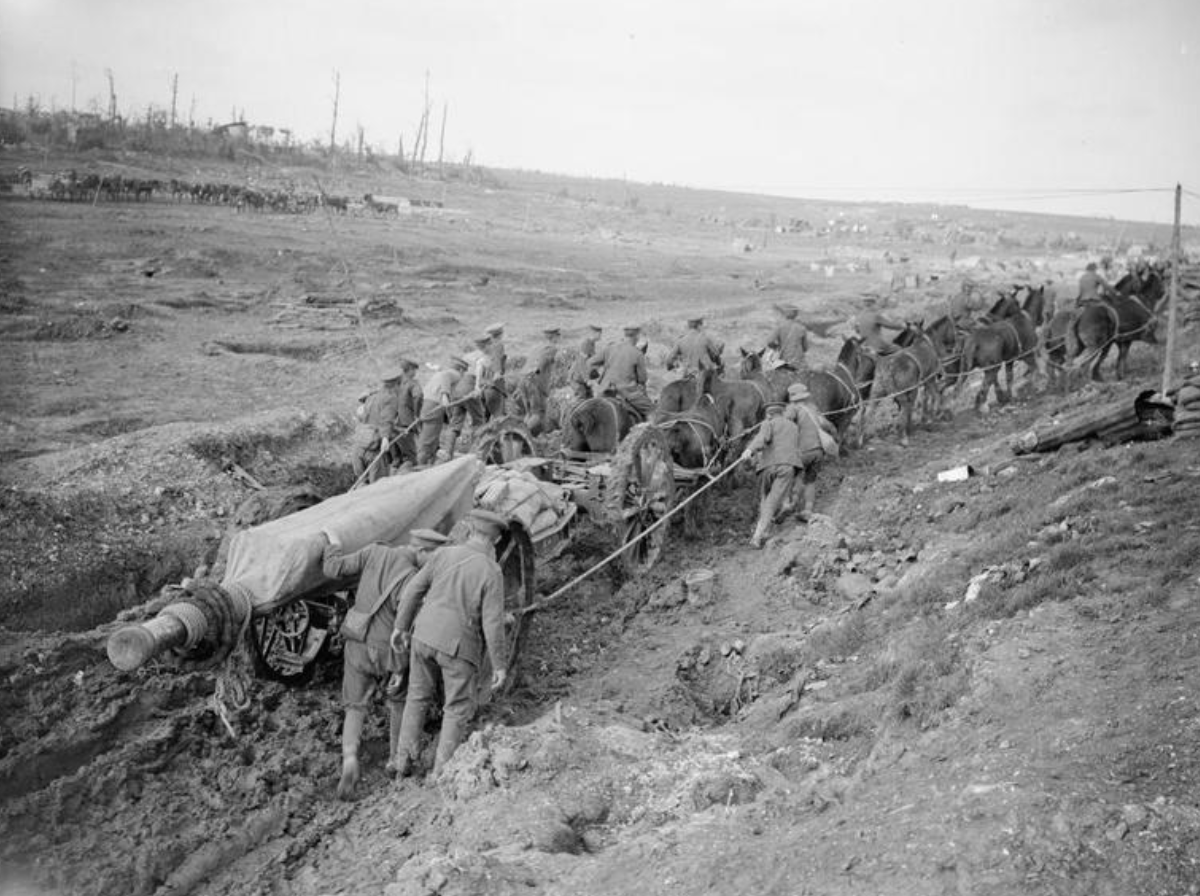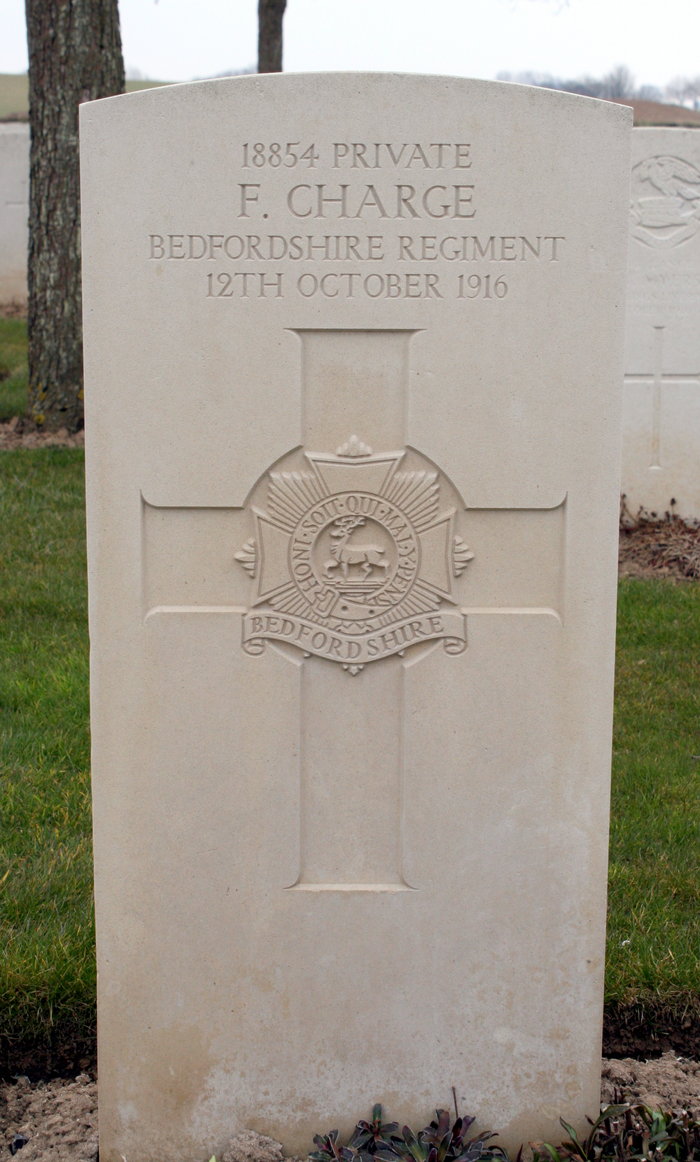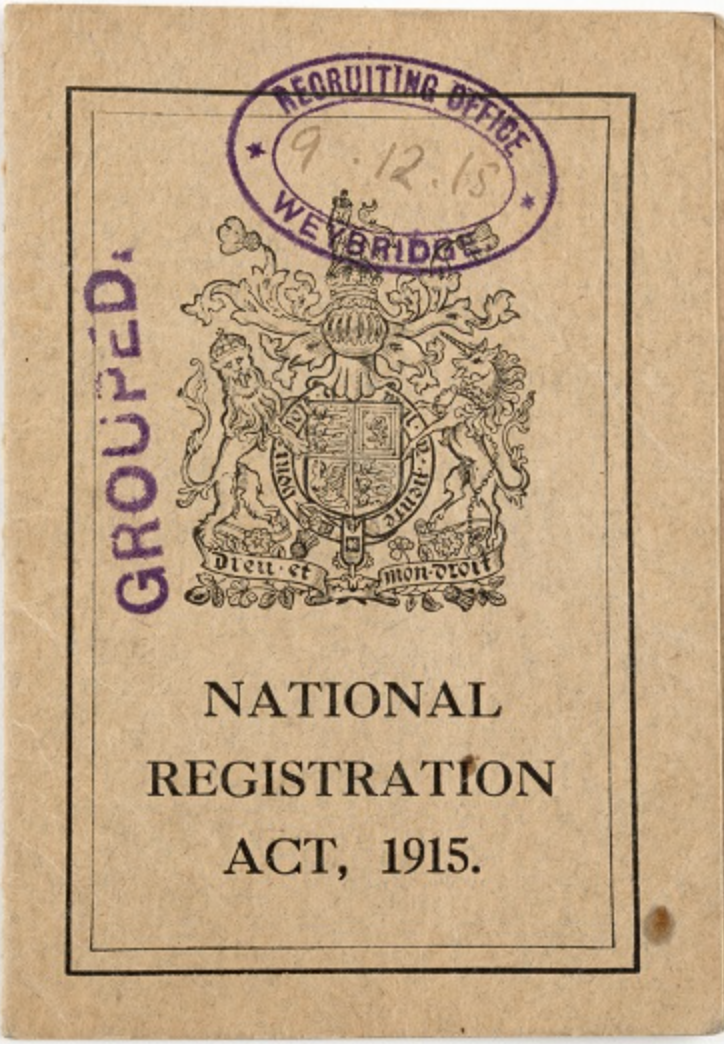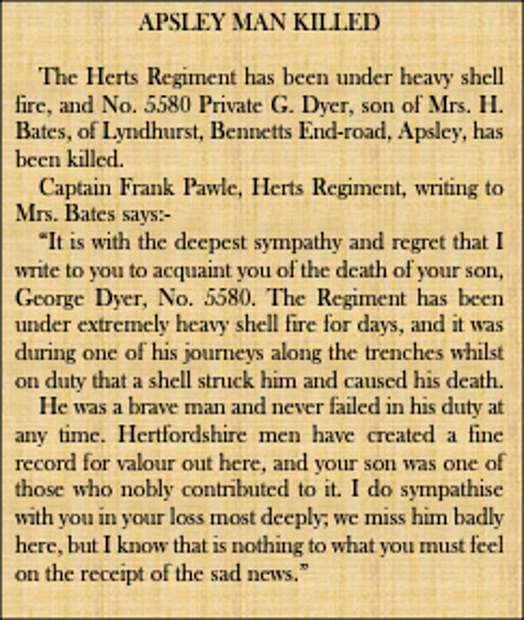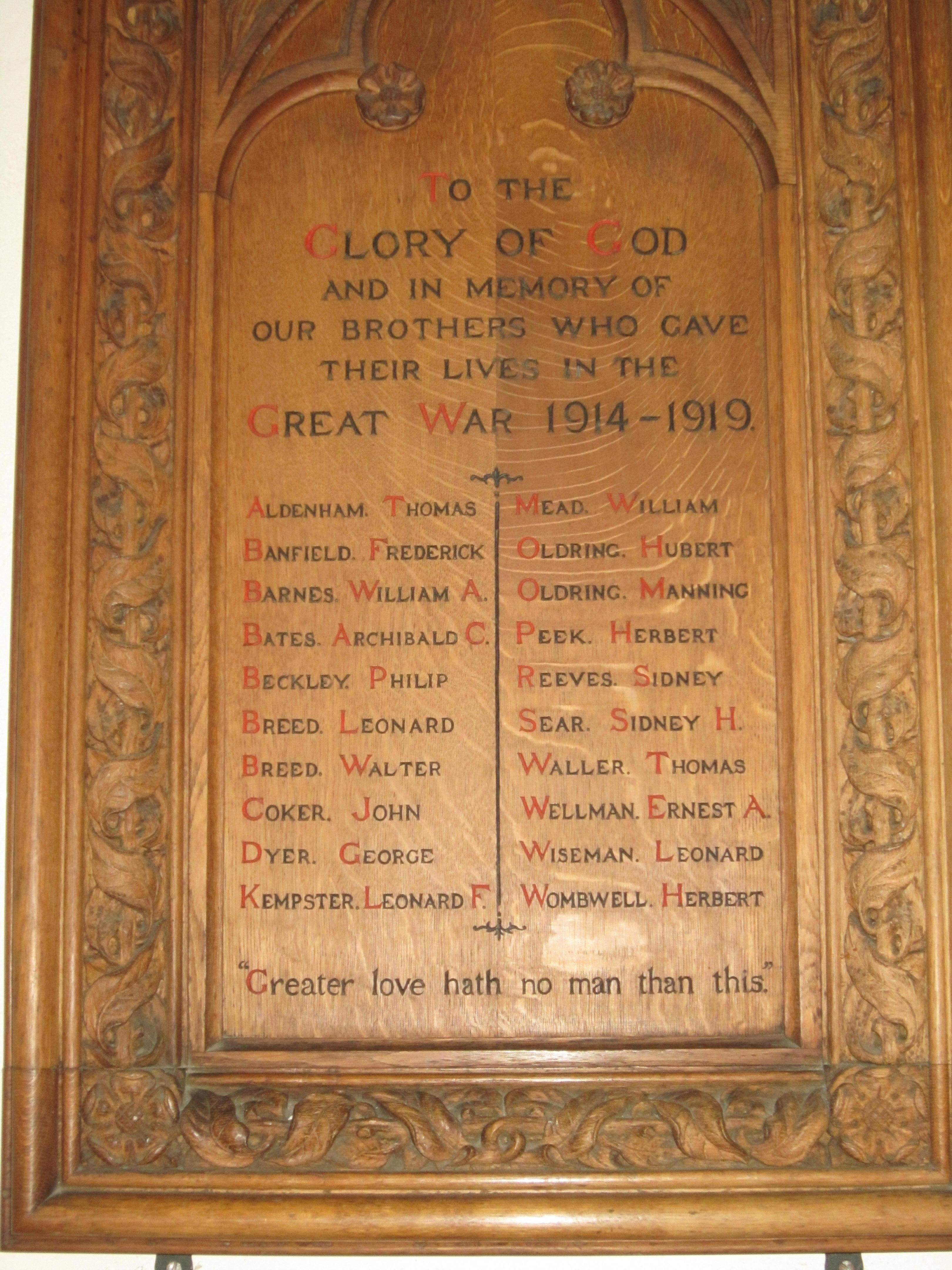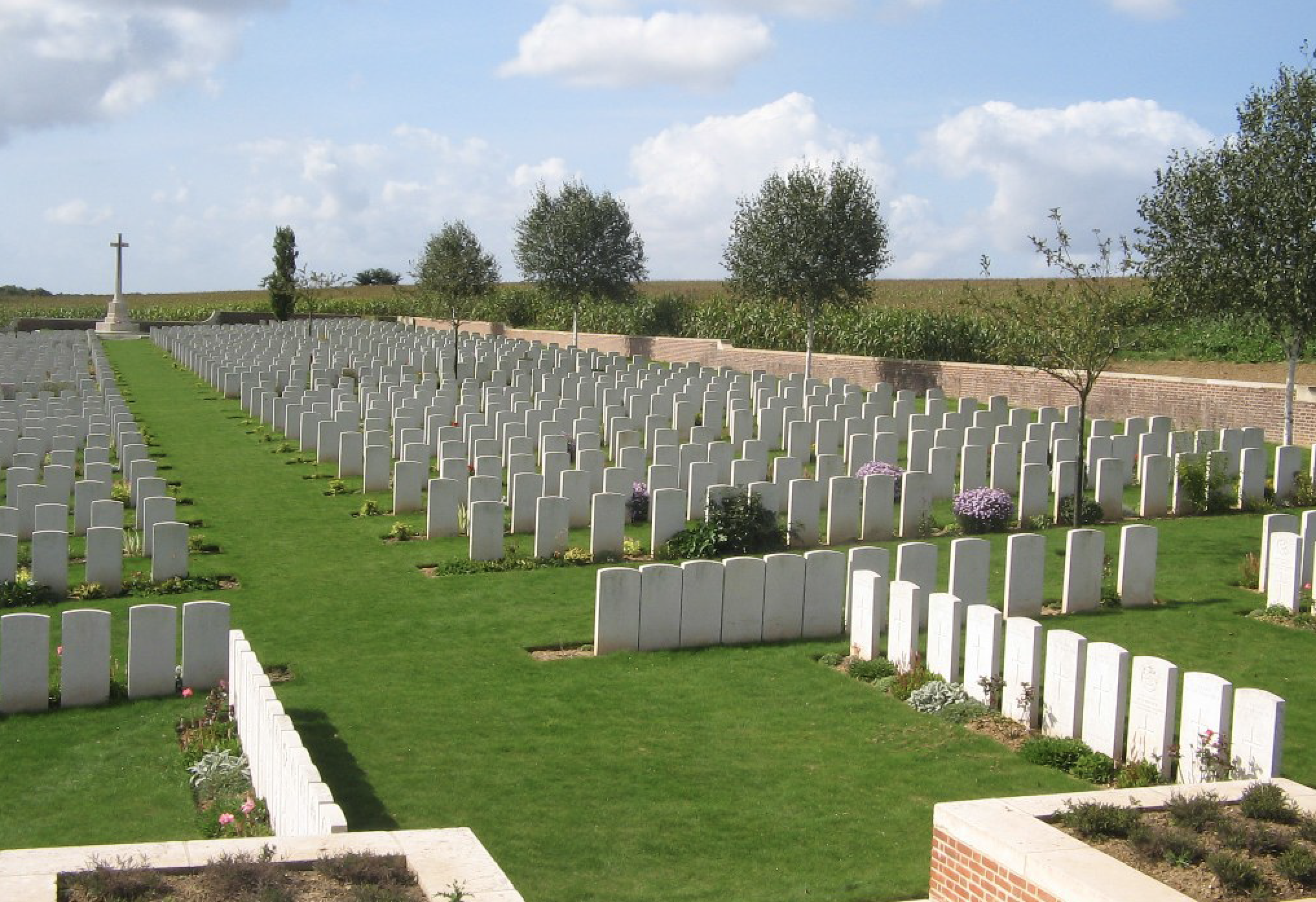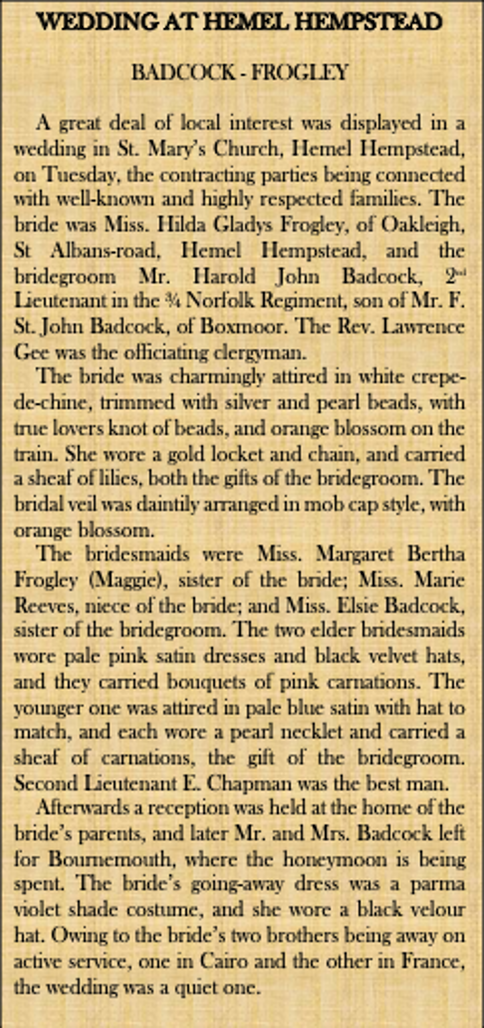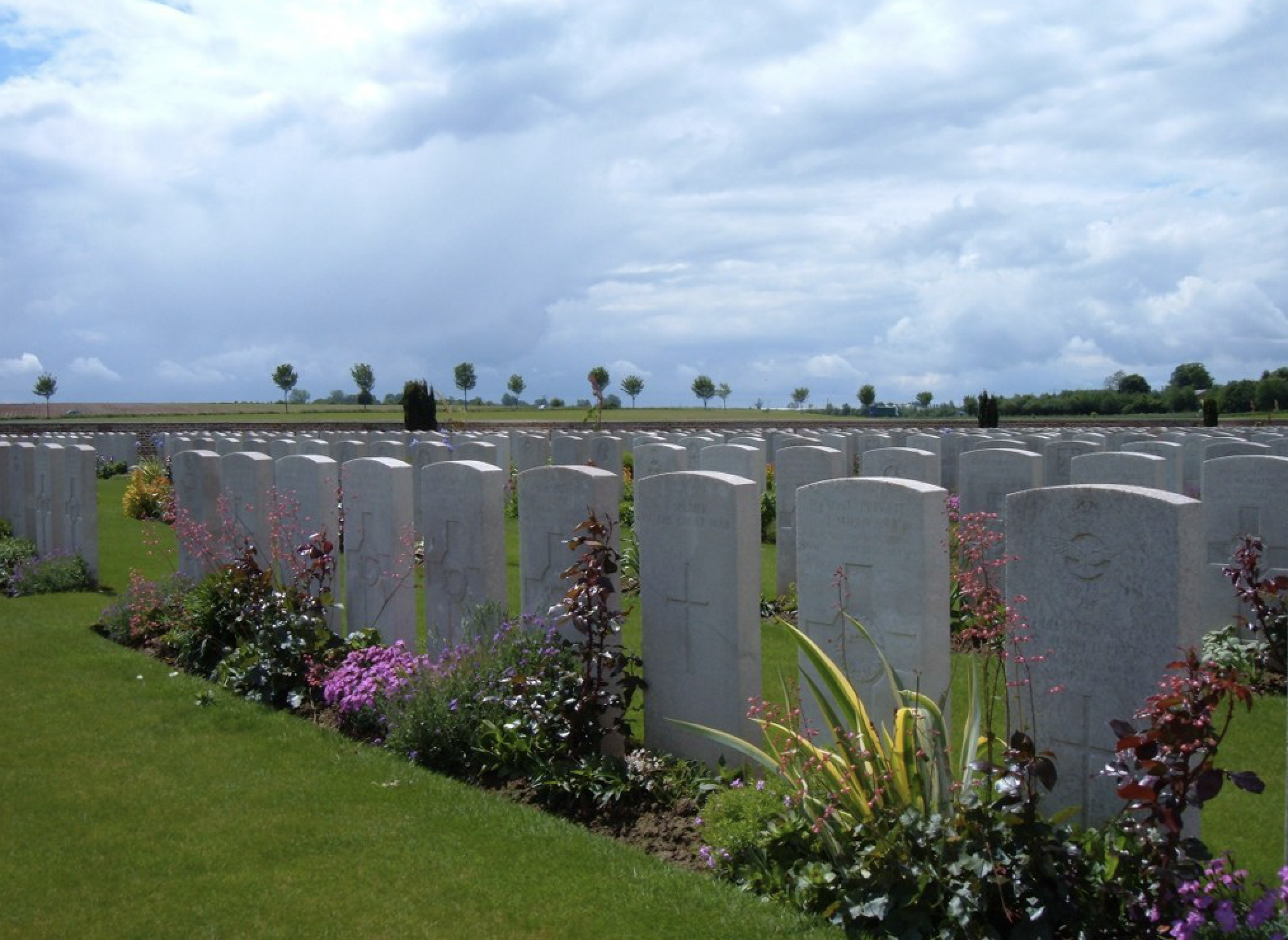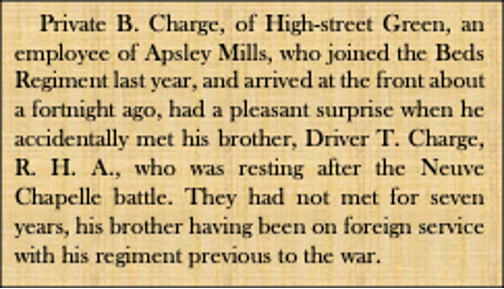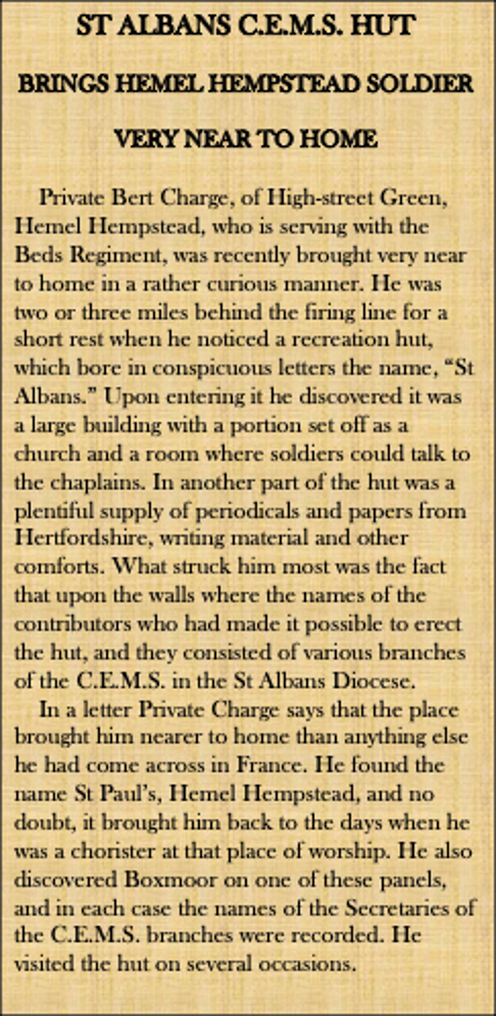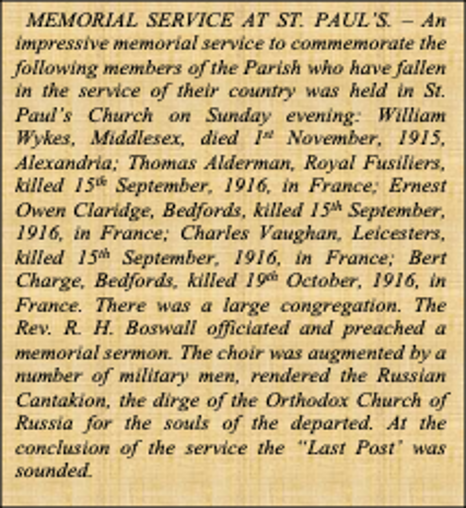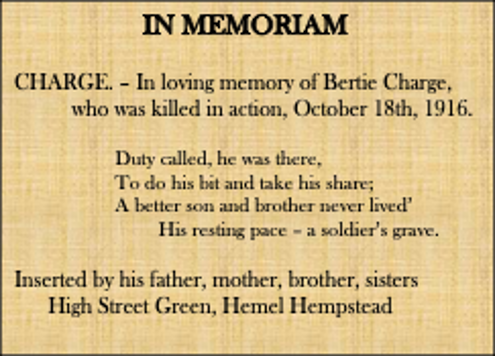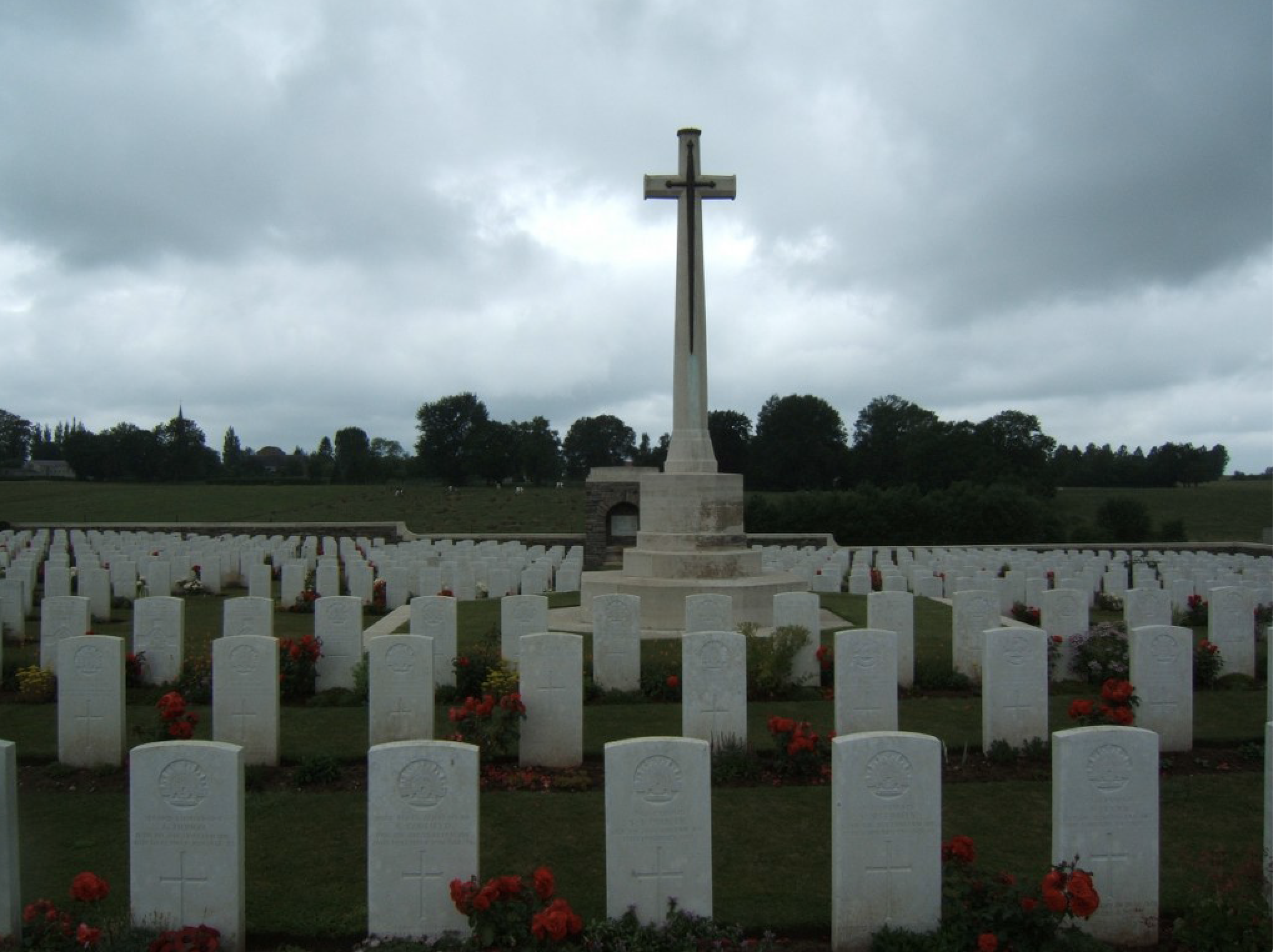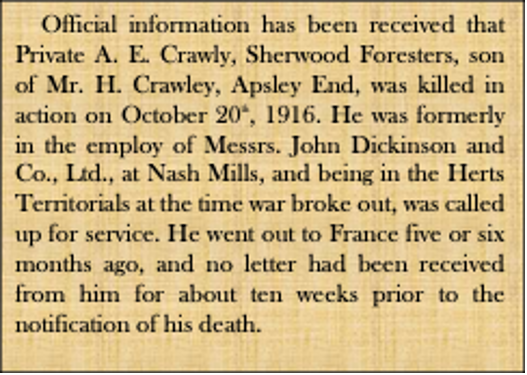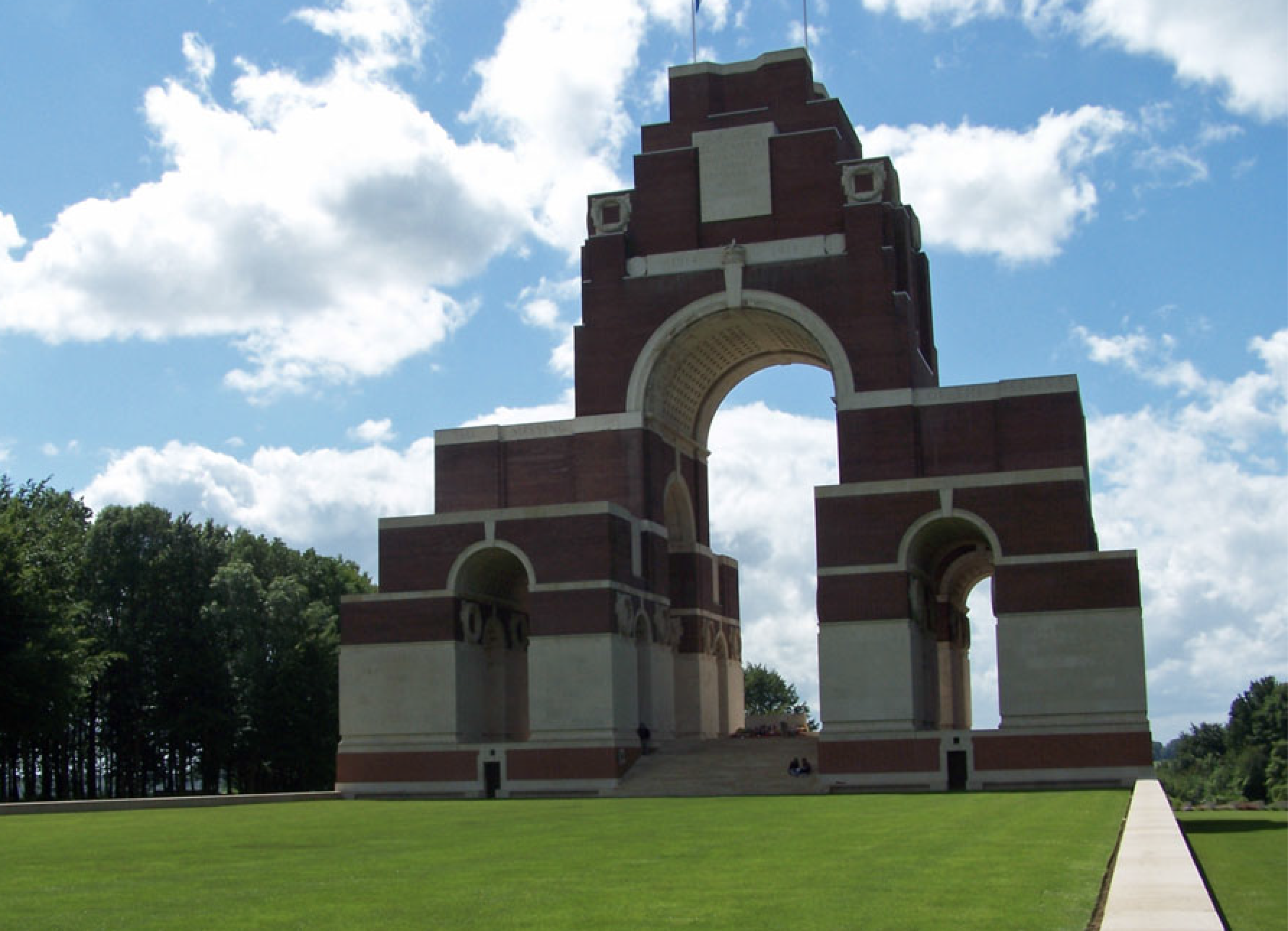Fallen in October 1916:
Albert Henry Jones
Thomas Chandler
Thomas Crockett
Frederick Carpenter
Fred Banfield
Frederick Charge
George Dyer
Harold John Badcock
Bertie Charge
Albert Edward Crawley
ALBERT H JONES
134107 Sapper
2nd Field Coy., Royal Engineers
Killed in Action Friday, 6th October 1916
Remembered with Honour, Philosophe British Cemetery, Mazingarbe, Pas-de-Calais, France, Grave I.G.17.
Albert Henry Jones was born in Camden Town, Middlesex in the Spring of 1882 the sixth child born to William Jones and Eliza Bowen. William and Eliza had eight children in total: Charles, Florence, Alice, William, Eleanor, Albert, Edith and Frederick.
In 1891 Albert’s family lived on Arundel Square in Islington, London where his father at the age of forty-six was a ‘G.P.O. Pensioner’. By 1901 the family had moved to Camden Street in Camden Town and nineteen-year-old Albert was working as a ‘Cabinet Maker’. It is likely that he was still indentured as an apprentice learning this highly skilled trade, possibly with a year left to serve.
Albert moved to Hemel Hempstead shortly after 1901 and started work with John Dickinson & Co. Limited at Apsley Mills. Whilst there he met Agnes Rose Barford, a ‘Printer’s Machinist’ at Dickinsons and in late 1905 they were married. Albert and Rose had three children together; Leslie Albert born in 1907, Margery Rose born in 1909 and Alfred born in 1913.
Albert volunteered for service under the Group (Derby) Scheme at the end of 1915. He attested at Watford in November and enlisted with the Royal Engineers, where his carpentry skills were a valuable asset, and was assigned to the 2nd Field Company. The Company came under the orders of the 8th Division and when he had completed his basic training Albert went to France.
The Royal Engineers carried out a number of different roles for the army both in the battlefield and along the lines of communication. The various specialisms were organised into different types of units. There were two sections to a field company, mounted and dismounted, and Albert was posted to the latter section. The dismounted section typically consisted of many kinds of trades required by the army in the field, and included fifteen Blacksmiths, twenty Bricklayers, forty Carpenters, five Clerks, twelve Masons, six Painters, eight Plumbers, along with surveyors, draughtsmen, wheelwrights, engine drivers amongst others.
Records do not reveal the date he disembarked in France, but in all likelihood, he went in May 1916 and as a result saw action at the Battle of Albert on the Somme in July 1916. By October the 8th Division was near the Hohenzollern Redoubt close to Loos-en-Gohelle and the Engineers were engaged in trench repair, boarding, digging sumps and sinking wells amongst other work. This involved activity in both Front Line and Support Trenches and exposed the Sappers to the same risks as other battalion troops.
It is not known how Albert was killed but he died when engaged in work on or near the Front Line on Friday, 6th October 1916.
Sappers of a Field Company Royal Engineers (Courtesy: https://www.longlongtrail.co.uk)
John Dickinson &Co Limited War Memorial Apsley (Courtesy: Traquair Photography 30th Aug. 2016)
Philosophe British Cemetery, Mazingarbe, Pas-de-Calais, France (Courtesy: CWGC)
Agnes, with three young children to raise, was granted a widow's pension and remarried in December 1917 to a serving soldier, Thomas Needham.
He was commemorated on the John Dickinson & Co. Limited war Memorial in Apsley and in St Mary’s church in the village.
Albert is Remembered with Honour in Philosophe British Cemetery, Mazingarbe, Pas-de-Calais, France, where he is interred in Grave I.G.17.
He was 34 years old when he died.
Albert was entitled to the British War Medal and the Allied Victory Medal.
THOMAS CHANDLER
250839 Private
1/3rd Bn., London Regiment (Royal Fusiliers)
Killed in Action Sunday, 8th October 1916
Remembered with Honour, Thiepval Memorial, Somme, France, Pier and Face 9D and 16B
Thomas Chandler was born in the Spring of 1892 in Boxmoor near Hemel Hempstead, the ninth child of Alfred Chandler and Susan Fountain. Alfred and Susan had thirteen children and there was over twenty-three years between the oldest and youngest. The children were: Jesse, Frederick, Arthur, Sarah Anne, Alfred, George, Marion, Joseph, Thomas, William Frank, Harry, Sidney and Archibald Bernard.
Three of the children died young, Joseph in 1893 aged three, Harry in 1898 aged four and one other at an unknown date. His older brother Joseph served with the Royal Flying Corps and survived the war. His younger brother Sidney also fought and died in the Great War. He was killed only two months before Thomas in August 1916 and his biography also appears on this site.
Thomas’ father Albert was a ‘Platelayer’ working for the London and North Western Railway (LNWR) and had brought his family to Boxmoor near Hemel Hempstead in the early 1890’s.
By the time of Thomas’ birth, the family were living at 63 London Road, Boxmoor in the ‘Railway Cottages’. These were homes which stood in front of Boxmoor station (now Hemel Hempstead) and were built to house workers and their families of the LNWR.
In 1911, eighteen-year-old Thomas was working as a ‘Railway Porter’ for LNWR at Bletchley station. His brothers Arthur and Sidney worked as; ‘Station-Master’ at St. Albans and a ‘Clerk’ at Apsley Paper Mills with John Dickinson & Co. Limited.
On the outbreak of war, Thomas enlisted at Edward Street, Deptford in London joining the 3rd (City of London) Battalion (Royal Fusiliers) in September 1914. It is possible his choice of regiment was because he had been working locally at Euston Station, the London terminus of the LNWR Company Limited.
The 3rd Londons was a Territorial Force and was initially engaged in guard duties in Malta and London at the outbreak of war. On completion of his training, Thomas was posted to the 2/3rd Londons and went to Malta disembarking on the 19th April 1915 where he remained until the Battalion was sent to Egypt five months later on the 15th September.
After disembarking at Port Said the Battalion was sent to garrison Khartoum in Sudan. Shortly afterwards it entered the Gallipoli Campaign when it landed at Suvla on the 26th September and was attached to the Regulars of 86th Brigade in the 29th Division.
During two months of trench holding the battalion lost approximately half its strength and when a great thunderstorm hit the peninsula on the 26th November, the trenches were flooded and engulfed by snow. The 2/3rd Londons were the worst hit of any unit: fifty men drowned and another thirty were evacuated with frostbite, leaving the battalion with an effective strength of just six officers and fifty other ranks.
Thomas was one of the unfortunate men who suffered frostbite and after some time in hospital on Mudros, he was evacuated back to England in January 1916 to complete his recovery. After seven moths at home he was considered fit enough to re-join his regiment and was posted to the 1/3rd Londons in France, disembarking there on the 25th August 1916.
On the 5th September 1916 the 1/3rd Londons were under the orders of the 168th Brigade in the 56th Division and went back into the line during the Battle of Ginchy where Thomas saw his first action in France. He next saw action when he fought in the Battle of Flers–Courcelette on the 15th September and the Battle of Morval ten days later. He survived each of these actions but was soon in the fray again at the Battle of Le Transloy.
The initial attack proved relatively successful on the 7th October but the following day in a follow-up attack the 1/3rd Londons failed to make any appreciable advance against heavy machine gun fire. The division was relieved the following night and Thomas was one of the forty-seven men posted missing from the attack.
He was subsequently confirmed killed on Sunday, 8th October 1916.
Before his death was officially confirmed, the Hemel Gazette published a plea from his mother Susan, for any information regarding her son’s fate. It appeared two days before Christmas Day in 1916 and speaks to the desperation of a mother who had already lost one son in the conflict. (see extract)
'Railway Cottages', Boxmoor where Thomas was born (Public Domain)
Bletchley Railway Station where Thomas worked (Courtesy: https://www.livingarchive.org.uk)
Extract from The Hertfordshire, Hemel Hempstead Gazette and West Herts Advertiser 23rd Dec. 1916
Thiepval Memorial, Somme, France (Courtesy: CWGC)
Thomas is Remembered with Honour on Thiepval Memorial, Somme, France, Pier and Face 9D and 16B.
He was 24 years old when he died.
Thomas was entitled to the 1914-15 Star, the British War Medal and the Allied Victory Medal.
THOMAS CROCKETT
6067 Private
1st/8th Bn., Middlesex Regiment
Killed in Action Monday, 9th October 1916
Remembered with Honour, Abbeville Communal Cemetery Extension, Somme, France, Grave I. H. 9.
Thomas Crockett was born on Monday, 19th September 1887 at Bourne End, Hertfordshire and baptised on Sunday, 6th November at St Lawrence Church, Bovingdon in the same year. His parents William Crockett and Charlotte Butler had a total of twelve children together who were: Albert, Arthur William, Arthur, Ernest, Alice Elizabeth (Lizzie), Henry (Harry), Richard (Dick), Nellie, Thomas and William and two other children who died in infancy and are not known. Arthur also died in infancy in 1871. Thomas’ brother Ernest, served in the Great War with the Army Service Corps and survived. His younger brother William also fought and died in 1915 but he is not commemorated on the Hemel Hempstead War Memorial. William’s biography appears in on this site on ‘The Missing Men’ page.
When Thomas was born the family was living at Bourne End and his father William worked as a ‘Footman’, possibly at one of the two large houses nearby in Box Lane; Boxmoor House or Boxlane House. By 1901 Thomas had started work aged thirteen and like his father, who had left domestic service, and two of his older brothers Harry and Dick, he was a ‘General Labourer’.
Thomas was called up to fight under the Group (Derby) Scheme in late 1915. He enlisted with the Middlesex Regiment attesting at Watford and joining the 1/8th (Territorial Force) Battalion. He was immediately sent to Hounslow to train and it is likely that he went to France, where he joined the Battalion in the Hallencourt area, the following June.
Shortly after arriving he saw action in the diversionary attack at Gommecourt on the 1st July, the first day of the Battle of the Somme. This was followed in September by three more battles at Ginchy, Flers-Courcelette and Morval all of which Thomas survived.
However, within two weeks he fell just as the Battle of Transloy Ridge began. The 8th Battalion had been in the trenches during the first eight days of October and had experienced heavy shelling by the enemy particularly on the 7th and 8th of the month.
At some point during these two days or possibly on the 9th when the Battalion was relieved, Thomas was fatally wounded. He died on the 9th October 1916.
Middlesex Regiment Cap Badge WW1
Abbeville Communal Cemetery Extension, Somme, France (Courtesy: CWGC)
Thomas is Remembered with Honour in Abbeville Communal Cemetery Extension, Somme, France where he is interred in Grave I. H. 9.
He was 29 years old when he died.
Thomas was entitled to the British War Medal and the Allied Victory Medal.
FREDERICK CARPENTER
40113 Private
7th Bn., Leicestershire Regiment
Killed in Action Wednesday, 11th October 1916
Remembered with Honour, Vermelles British Cemetery, Pas-de-Calais, France, Grave V.E.20.
Frederick John Carpenter, known as Fred, was born in Boxmoor, Hertfordshire on Tuesday, 27th April 1886 and baptised a year later on Wednesday, 13th April 1887 at St. John’s Church in the village. He was the fifth child born to Henry Carpenter and Anne Elizabeth Ellis who had eight children together. The children were: William, Annie, Alice, Henry, Fred, Ben, Rose and Walter.
Fred’s father Henry had been born and grew up in the Crouchfield area of Boxmoor and when Fred was born the family was living close to Crouchfield on St. John’s Road. Henry would remain there until his death.
Fred started his education at Boxmoor JMI School in 1891 and he successfully completed Standards I to VI by the time he left in April 1899. He left to work as a ‘Carter’ on a farm at the age of thirteen and he would continue with farm work for the next sixteen years until he went to war.
He was called up under the Group (Derby) Scheme and enlisted in November 1915, attesting in Watford and joining the Leicestershire Regiment. He was posted to 1/5th Battalion to train and although records do not reveal when Fred was sent to France, it is likely that he undertook basic training for six months, so he was probably in France by June of 1916.
When he did go to France Fred was posted to the 7th (Service) Battalion under the orders of 110th Brigade, (‘The Leicester Tigers Brigade’), in the 21st Division. He saw action the Battle of Flers-Courcelette, the Battle of Morval in which the Division captured Gueudecourt and finally the Battle of Le Transloy.
Shortly after the start of the Battle of Transloy, the Battalion moved to Bethune and relieved the Royal Irish Rifles in the Hohenzollern section of trenches. The Battalion war diary records that on the 10th October “Nothing of importance happened during tour of duty in front line” however, on the following day the only entry reads: “One man killed.” The man killed was the unfortunate Fred Carpenter.
Fred was killed on Wednesday, 11th October 1916.
Boxmoor JMI School (Courtesy: ©Peter Wagon Fine Arts www.peterwagonfinearts.co.uk)
Vermelles British Cemetery, Pas-de-Calais, France (Courtesy: CWGC)
Fred is Remembered with Honour in Vermelles British Cemetery, Pas-de-Calais, France where he is interred in Grave V.E.20. The inscription on his headstone, requested by his mother Anne reads: “HE WENT AT DUTY'S CALL NOW HE LIES IN A HERO'S GRAVE”.
He was 29 years old when he died.
Fred was entitled to the British War Medal and the Allied Victory Medal.
FRED BANFIELD
7885 Private
2nd Bn., Bedfordshire Regiment
Killed in Action Thursday, 12th October 1916
Remembered with Honour, Thiepval Memorial, Somme, France, Pier and Face 2 C
Frederick William Banfield, known as Fred, was born in March 1885 in Hemel Hempstead, Hertfordshire. He was the second child born to William Banfield and Ann Puddephat who had ten children who were: Emily, Fred, William, Eliza Ann, Bertie, Harry, Ann, Tom, Jack and Lily. Fred’s father William died in 1903 aged forty-six and six years later, his mother Ann married for a second time to George Wilson from Hemel Hempstead. Fred’s sister Ann died in 1913 aged eighteen.
When Fred was born his family lived at 5 Edmund’s Place which was located were ‘Bank Court’ in Hemel Hempstead stands today. His father William was a ‘General Labourer’ whilst his mother Ann worked as a ‘Laundress’.
In 1901 the Banfield family had moved a short distance to the other side of the River Gade and now lived at 120 Cotterell’s Road (Cotterells). Fred’s father worked as a ‘Yardman’ and ‘Miller’ for Edward Mead at Bury Corn Mill, whilst sixteen-year-old Fred worked as a ‘Blacksmith’. He was employed by Davis & Bailey at Boxmoor Iron Works, a business started in 1841 as a specialist producer of a wide variety of good quality agricultural implements with the provision of a repair service.
An example of the company’s work can still be seen at the north end of the High Street in Hemel Hempstead Old Town, where one of its model ‘A 12’ ploughs, made in 1900, stands today. Perhaps young Fred had a hand in its manufacture.
Fred was working at Boxmoor Iron Works when he enlisted in the Militia on reaching his eighteenth birthday in March 1903. When he joined the 4th Battalion Bedfordshire Regiment his Attestation Form describes him as 5ft 3½ins tall, weighing a very lean 7st 10lbs, with grey eyes, brown hair and having a Fresh complexion. He clearly felt that Army life suited him and, on the 28th December 1903, only eight months after joining the Militia, he enlisted in the regular army with the 2nd Battalion Bedfordshire regiment. He would remain a professional soldier until his death.
Fred was stationed at Borden Camp, Petersfield in Hampshire in 1904 before moving to Tidworth Camp in Wiltshire two years later. A stint on Gibraltar in 1907 was followed by a move to Bermuda in 1909, where the Battalion remained until South Africa beckoned in 1912.
On the outbreak of war, the Battalion was immediately recalled to England to prepare to go to Belgium, which it did in October 1914, disembarking at Zeebrugge and marching south towards Ypres.
On the 18th October Fred saw his first action when the 2nd Battalion was part of the 21st Division’s attack on Menin in the First Battle of Ypres.
During 1915, Fred fought in The Battle of Neuve Chapelle in March, the Battle of Festubert in May, the Second Action at Givenchy in June and the Battle of Loos in September.
In 1916 he was in action in The Battle of the Somme, namely the Battle of Albert (including the opening day when the division broke the German lines, and in the assault on Trônes Wood on the 11th July). The Battle of Delville Wood followed in July, and finally he fought in the Battle of Le Transloy in October.
The fighting at Transloy on the 12th October was fierce and waves of attacks by the 2nd Battalion encountered heavy machine gun fire and shelling from the enemy positions. The assaults continued until darkness fell and some gains were made as recorded in the Battalion War Diary as follows: "The total gains of the day were about 200 yards of BITE TRENCH and about 70 yards of GIRD TRENCH. The Battalion did magnificently and were the only Battalion to gain any ground on the whole of the Corps Front, all the others having to withdraw to their front trenches."
However, these gains came a high cost and the casualties were as follows: "Officers = 10: Killed 5 Died of Wounds 1 Wounded 1 Wounded at Duty 3. Other Ranks = 242: Killed 49 Missing 49 Wounded & Missing 2 Wounded 125 Shell Shock 5 Wounded at Duty 12."
Fred was one of the 49 men killed and he died on Thursday, 12th October 1916.
He was commemorated, along with seven other members of the congregation who had fallen, in a memorial service at Marlowes Baptist Church on Sunday, 29th October 1916. A brief report of the service was published in the Hemel Gazette a week later. (see extract)
Boxmoor Iron Works where Fred worked (Courtesy: Old OS Maps https://www.old-maps.co.uk)
Is Fred in this photograph? Employees at the entrance to Boxmoor Iron Works (Courtesy:https://www.ourdacorum.org.uk)
Extract from The Hertfordshire, Hemel Hempstead Gazette and West Herts Advertiser 4th Nov. 1916
Thiepval Memorial, Somme, France (Courtesy: CWGC)
He is commemorated on a memorial plaque in Marlowes Baptist Church.
Fred is Remembered with Honour on Thiepval Memorial, Somme, France, Pier and Face 2 C.
He was 29 years old when he died.
Fred was entitled to the 1914-15 Star, the British War Medal and the Allied Victory Medal.
FREDERICK CHARGE
18854 Private
2nd Bn., Bedfordshire Regiment
Killed in Action Thursday, 12th October 1916
Remembered with Honour, Warlencourt British Cemetery, Pas-de-Calais, France, III. D. 11.
Frederick Charles Charge, known as Fred, was born at Highwood Hall, Pimlico near Leverstock Green, Hertfordshire on Wednesday, 6th November 1895 and baptised at Holy Trinity in the village on Sunday, 12th January 1896. He was the second of three children born to Arthur Charge and Lavinia Smith whose other children were Daisy and George. Fred also had two half siblings; William Smith born to Lavinia in 1883 before she married Arthur; and Harold born in 1890, who was Arthur’s son from his first marriage to Alice Dolt who sadly died only ten months after Harold’s birth.
When Fred was born his father worked as a ‘Shepherd’ at Highwood Hall Farm where the family lived. Ten years later in 1911, Fred, his father and two of his brothers are all working on the land. Fifteen-year-old Fred is a ‘Stockman’, his father is a ‘Farm Labourer’ and his brothers William and Harold worked as ‘Ploughman’ and ‘Poultryman’ respectively. It is likely that they were all employed on Highwood Hall Farm.
On the outbreak of war in August 1914, Fred was eighteen years old, but he delayed enlisting until he was nineteen and eligible for service overseas. He went to Bedford where he attested in the second week of January 1915 and joined the Bedfordshire Regiment.
He spent eight months training before being sent to France on the 30th September 1915 when he was posted to the 2nd Battalion Bedfordshire Regiment. He arrived at the Cuinchy Billets at Le Quesnoy in France on the 4th October with a draft of 250 other soldiers, much needed reinforcements after the Battalion losses at the Battle of Loos.
During 1916, Fred was in action in several phases of The Battle of the Somme, starting at the Battle of Albert and the Battle of Delville Wood in July. Just over two months later he fought in the Battle of Le Transloy in October.
The Battle of Le Transloy was the last offensive of the Fourth Army of the British Expeditionary Force (BEF) in the 1916 Battle of the Somme. The fighting took place during worsening weather and dreadful battlefield conditions. The initial attack was launched on the 1st October and was met by fierce German resistance meaning that it was not until the afternoon of 3rd October that the objectives were secured. A follow-up attack was delayed by atrocious weather and when it commenced on the 7th October the British suffered heavy British casualties and achieved little. The failure to secure original battle objectives led to a renewed assault on the afternoon of the 12th October when infantry floundered towards German trench lines in front of Le Transloy and formations on the left flank slogged towards the Butte de Warlencourt. Gains were small with the 2nd Bedfords capturing only 70yds of enemy trench but at very high cost.
The Battalion War Diary recorded the casualty figures as follows: "Officers = 10: Killed 5 Died of Wounds 1 Wounded 1 Wounded at Duty 3. Other Ranks = 242: Killed 49 Missing 49 Wounded & Missing 2 Wounded 125 Shell Shock 5 Wounded at Duty 12."
Fred was amongst the forty-nine men killed and he died on Thursday, 12th October 1916.
He was commemorated in memorial service at Holy Trinity Church in Leverstock Green at Easter 1919 and was remembered on the village school memorial and on the Leverstock Green War Memorial.
Fred is Remembered with Honour in Warlencourt British Cemetery, Pas-de-Calais, France where he is interred in Grave III. D. 11.
He was only 20 years old when he died.
Fred was entitled to the 1914-15 Star, the British War Medal and the Allied Victory Medal.
Highwood Hall Farm where Fred was born (Courtesy:https://maps.nls.uk)
Transloy Ridge where Fred fell (Courtesy: IWM)
Leverstock Green Village War Memorial (Courtesy: Traquair Photography 23rd Aug. 2016)
Pte. Frederick Charge - Warlencourt British Cemetery, Pas-de-Calais, France (Courtesy: Traquair Photography 20th Mar. 2016)
GEORGE DYER
5580 Private
1st Bn., Hertfordshire Regiment
Killed in Action Saturday, 14th October 1916
Remembered with Honour, Lonsdale Cemetery, Authuille, Somme, France, Grave X. B. 5.
George Lewis Dyer was the only son born to Harriet Dyer from Eaton Bray in Hertfordshire. He was born in the Autumn of 1891 in Hemel Hempstead and spent his early years living on Bury Road before his mother married Harry Bates in 1902 when George was eleven years old. His step-father was a widower with four children, so following the marriage George gained three new step-brothers, Percy, Harry and Archie and a step-sister Bertha. These new siblings were soon followed by another half-sister Ethel and a half-brother Edward.
His three step-brothers Percy, Archie and Harry all saw service in the Great War. Percy and Harry survived but Archie was killed almost exactly a year to the day after George and his biography also appears on this site.
When young George left school, he started work in a local brewery where he trained as a ‘Maltsters Labourer’, possibly in the ‘Anchor’ or ‘Star’ breweries situated on or close to Bury Road where he had lived. In his early twenties he joined John Dickinson & Co Limited in Apsley Mills where five of his family already worked.
George enlisted under the Group or Derby Scheme, attesting in Hemel Hempstead in October 1915 and joining the Hertfordshire Regiment. He was posted initially to the 3rd Battalion at Hertford where he underwent his basic training before he was sent to France in early April 1916 as a draft to reinforce the 1st Battalion Hertfordshires.
He saw action in the trenches over the next few months in the vicinity of Festubert before the Battalion fought in the Battle of Ancre Heights in October, the last action of the Somme offensive. It fulfilled mainly a support role but despite this suffered heavy enemy shelling for prolonged periods and it was as a result of being hit by a shell that George was unfortunately killed.
He died on Saturday, 14th October 1916.
George’s death was reported in the Hemel Gazette in late October 1916 along with a letter of sympathy from his C.O. Capt. Frank Pawle. (see extract)
George was honoured in a memorial service, on the 29th October 1916, at Marlowes Baptist church along with seven other members of the congregation who had fallen in the Great War, a brief report of which appeared in the Hemel Gazette only three weeks after his death.
He is commemorated on the memorial plaque in the Marlowes Baptist Church and on the John Dickinson & Co Limited war memorial in Apsley.
George is Remembered with Honour in Lonsdale Cemetery, Authuille, Somme, France where he is interred in Grave X. B. 5.
He was 25 years old when he died.
George was entitled to the British War Medal and the Allied Victory Medal.
John Dickinson & Co Limited war memorial, Apsley (Courtesy: Traquair Photography 26th Aug 2016)
National Registration Act which instigated the Group (Derby) Scheme (Courtesy:http://www.elmbridgemuseum.org.uk)
Extract from The Hertfordshire, Hemel Hempstead Gazette and West Herts Advertiser 28th Oct. 1916
Marlowes Baptist Church, Hemel Hempstead (Courtesy: Kathleen McLeod 1st April 2018)
Lonsdale Cemetery, Authuille, Somme, France (Courtesy: CWGC)
HAROLD JOHN BADCOCK
2nd Lieutenant
4th Bn., Norfolk Regiment
Killed in Action Wednesday, 18th October 1916
Remembered with Honour, Bancourt British Cemetery, Pas-de-Calais, France, Grave VIII. D. 14.
Harold John Badcock was born on Tuesday, 28th February 1888 in Hemel Hempstead, the fourth son and child born to Frederick St John Badcock and Marian Sparkes. Harold had three older brothers and two younger sisters who were: Charles, Frank, Percy, Elsie and Dorothy.
When Harold was born, his family lived in the ‘School House’ at Boxmoor Junior Middle and Infants school on St. John’s Road in Boxmoor, where his father Frederick was the Head teacher.
By 1901, Harold, Percy and Elsie were all at their father’s school where their older brother Frank was also a teacher. It appears that Harold initially continued the family tradition and trained for the teaching profession when he left school however, he did not pursue this choice of career. Misfortune visited the Badcock family in 1906 when Harold’s mother Marian died aged forty-nine, leaving his father Frederick to raise the family.
Harold joined the police force, possibly in the same year that his mother died, when he reached the minimum entry age of eighteen. The police force provided a secure job at this time and although the income for a ‘Police Constable’ was low, the benefits of the job were attractive and included the provision of a pension. Recruitment was strictly selective and new entrants had to be between eighteen and twenty-seven-years old, at least 5ft 10ins tall and in good health, resulting in only one in five applicants being successful.
Harold’s initial training with the police force in Hemel Hempstead is likely to be the reason he met his future wife, Hilda Gladys Frogley, whose father Frederic was the Superintendent of Police in Hemel Hempstead for the best part of two decades between 1892 and 1918. Hilda was born on Alma Road in Hemel Hempstead but grew up in the old Police Station at the bottom of Bury Hill opposite Bury Mill. The old Police Station, now flats called ‘Century House,’ still stands today.
By 1911 Harold was a ‘Police Constable’ with Lincolnshire County Constabulary and lived at 59 Cranwell Road, Lincoln where he boarded at the home of Arthur and Rose Wesley. Also living in the Wesley home were William Welsh and Albert Platts, both recorded as ‘Professional Footballers’ playing for Lincoln City at the nearby ‘Sincil Bank’ ground. Albert Platts played twenty-nine times for Lincoln City as an ‘inside left’ between 1910 and 1913 scoring four goals.
By the time war was declared, Harold had transferred to King’s Lynn Police Force in the Norfolk Constabulary and worked as ‘Chief Clerk’. His tenure at King’s Lynn probably resulted in his decision to join the Norfolk Regiment. He applied for a commission with the 3/4th Norfolk Regiment TF on his enlistment at the Drill Hall in Norwich on the 7th July 1915 and this was approved three days later. He was Gazetted 2nd Lieutenant on the 28th July 1915 and began his training prior to going to France.
Harold was granted leave four months later and returned to Hemel Hempstead where he and Hilda were married on Tuesday, 12th October 1915 at St Paul’s Church in the town. Considered something of a ‘society’ wedding, the marriage was reported in the next edition of the Hemel Gazette. (see extract)
Harold and Hilda had a brief honeymoon in Bournemouth before he returned to his regiment at Norwich. The report also mentions two of Hilda’s brothers who were absent because they were away on active service. The brothers were Arthur Leslie who served with the Royal Army Service Corps as a ‘Lorry Driver’ and Cecil Lloyd who served with the Rifle Brigade as ‘Transport Serjeant’. Both men survived the conflict and both subsequently worked for many years as ‘Chauffeurs’.
The 3/4th Norfolks was a Reserve battalion and served in the UK throughout the war, but in late 1916 Harold was posted to the 9th (Service) Battalion and went to France. He disembarked at Boulogne on the 30th September 1916 and joined the Battalion near Albert five days later on the 4th October.
The Battalion moved to Montaubin three days after Harold arrived and from here went into the front-line trenches on the 16th October relieving the 18th Infantry Brigade. The Battalion War Diary recorded the events over the next two days as follows: "17.10 Support line subjected to very heavy bombardment but suffered very few casualties. 18.10 Attack launched at 3.40 a.m. part of Mild Trench being successfully occupied. Casualties 239 O.R and the following Officers Killed 2/Lt Page T.S Wounded 2/Lt Beesley R.G.G 2/Lt Clarke J.W Capt. Rowell C.G.S 2/Lt Henshall H.H 2/Lt Cowles W.R 2/Lt Gravestock Missing 2/Lt Page J.C 2/Lt Badcock H.J."
It would be another seven months before Harold was officially confirmed dead on 25th May 1917 and just three months later his father Francis also passed away. Harold had been Killed in Action on Wednesday, 18th October 1916.
At the time of his death he had been in France for only nineteen days and tragically died on his second day in action at the Battle of Transloy. His comrades noted that he was last seen on a ‘German parapet’ during the attack near Bapaume and was presumably killed shortly afterwards.
When his body was eventually recovered he was buried at Beaulencourt Road Cemetery just south-west of Bapaume, but this graveyard was partially destroyed and most of the soldiers buried there where re-interred at Bancourt British Ceremony about five miles away to the north-east.
He is commemorated on a memorial plaque inside St John’s Church in Boxmoor, Hemel Hempstead.
Harold is Remembered with Honour in Bancourt British Cemetery, Pas-de-Calais, France where he is interred in Grave VIII. D. 14. The inscription on his headstone, requested by his wife Hilda, reads: “FAITHFUL UNTO DEATH”.
He was 28 years old when he died.
Harold was entitled to the British War Medal and the Allied Victory Medal.
2nd Lieutenant Harold John Badcock c1915: (Courtesy: IWM - Bond of Sacrifice, First World War Portraits Collection)
Boxmoor JMI School where Harold’s father was Head Teacher (Courtesy: ©Peter Wagon Fine Arts (www.peterwagonfinearts.co.uk)
Extract from The Hertfordshire, Hemel Hempstead Gazette and West Herts Advertiser 16th Oct. 1915
St John’s Church War Memorial (Courtesy: ©Richard Grayson, February 2014)
Bancourt British Cemetery, Pas-de-Calais, France (Courtesy: CWGC)
BERTIE CHARGE
13013 Private
2nd Bn., Bedfordshire Regiment
Killed in Action Wednesday, 18th October 1916
Remembered with Honour, Bulls Road Cemetery, Flers, Somme, France, Grave III. D. 30
Bertie Charge was born at Hobblett’s Orchard on High Street Green to the west of Hemel Hempstead in January 1892 and baptised in St. Paul’s Church on Sunday, 6th March in the same year. He was the youngest son born to David Charge and Lydia Hitchcock who had ten children, five of whom died. The surviving children were: William, Bertha, Thomas, Bertie and Winifred May. The children who died were all girls: Alice, Elizabeth, Eliza, Katie and Fanny and they had all passed away before 1901. Bertie’s brother Thomas was a regular soldier and served in the Great War as a Driver in the Royal Horse Artillery and survived the conflict.
Bertie’s father David was a ‘Brickmaker’ and was employed in the brickworks behind Maylands Wood just a short walk from the family home. When Bertie left school in 1905 he went to work for John Dickinson & Co. Limited as a ‘Bookbinder’ at Apsley Mills and he remained there until he joined the Colours.
On the declaration of war Bertie attested at Hemel Hempstead in the first week of September 1914 and enlisted with the Bedfordshire Regiment. He underwent basic training at Bedford before being posted to the 2nd Battalion and sent to France, disembarking at Le Havre on the 17th March 1915.
Bertie was part of a draft of 101 men sent to reinforce the Battalion which had suffered heavy losses at the Battle of Neuve-Chapelle a short time before. He arrived on the 20th March in the esteemed company of the new C.O. Major John Henry MacKenzie V.C. D.C.M., who fell just two months later at the head of his men on the 17th May 1915 in the Battle of Festubert.
About a fortnight after arriving in France, Bertie unexpectedly met his brother Thomas, whom he had not seen for seven years on account of Thomas serving overseas as a regular soldier. The happy coincidence was reported in the Hemel Gazette under ‘Local War Items’, a regular local interest feature in the paper in the early years of the War. (see extract)
Not long after this meeting, Bertie was one of 276 men wounded in the Battle of Festubert and his condition was serious enough to take him down the line and back to England to recuperate. He remained in hospital in England and at home in Hemel Hempstead until August 1916 when he was sent back to France.
Bertie was an active member of St Paul’s Church in Hemel Hempstead and, as well as having been a chorister, he was a member of the Church of England Men’s Society (CEMS), This Society had been founded 1899 by Archbishop Frederick Temple with the objective of bringing men together to socialise in a Christian environment. Many young men like Bertie were members of the CEMS which was also intended to be educational, social and representative of the Church of England. In the early years of the 20th Century the Society's rapid expansion led to the formation of federations and diocesan unions all across the UK.
On his return to France, Bertie wrote to his family to recount an incident which brought him closer to home and which was reported in the Hemel Gazette. He described how he came across a ‘recreation hut’ two or three miles behind the line which bore the name “St. Albans”. (see extract)
On further investigation, Bertie discovered writing materials in part of the hut along with periodicals and papers from Hertfordshire. He noticed that the contributors who had made it possible to erect the hut were the various branches of the CEMS in the St. Albans diocese. The presence of the hut and the material available clearly provided some comfort to the men at the front and Bertie subsequently made several further visits.
This report appeared in the Gazette less than two weeks before Bertie died after he was wounded during or just after the Battle of Transloy. There is some confusion regarding the date of his death with the 18th, 19th and 20th October all given as his final day. However, what is clear is that the action at Transloy was costly in the extreme for the 2nd Battalion Bedfordshire Regiment and the War Diaries record the casualties as follows: "13th October 1916 - Officers = 10 Killed 5 Died of Wounds 1 Wounded 1 Wounded at Duty 3 Other Ranks = 242 Killed 49 Missing 49 Wounded & Missing 2 Wounded 125 Shell Shock 5 Wounded at Duty."
It is highly likely that Bertie received his wounds during the battle and probably evacuated to a Casualty Clearing Station and possibly to a base hospital where he succumbed to his injuries.
Bertie’s ‘Register of Effects’ records his date of death as Wednesday, 18th October 1916.
His death was reported in the Hemel Gazette the following month as were details of a memorial service at St Paul’s Church on Sunday, 5th November 1916, in which he was commemorated along with four other members of the congregation who had fallen. (see extract)
On the first anniversary of his death Bertie’s family inserted a touching ‘In Memoriam’ notice in the Gazette. (see extract)
He was commemorated on the John Dickinson & Co Limited War Memorial in Apsley and on a plaque which was erected in the old St Paul’s Church in Hemel Hempstead.
Bertie is Remembered with Honour in Bulls Road Cemetery, Flers, Somme, France where he is interred in Grave III. D. 30. The inscription on his headstone, requested by his parents, reads: “IT WAS HARD TO PART WITH ONE WE ALL LOVED SO DEAR”.
He was 24 years old when he died.
Bertie was entitled to the 1914-15 Star, the British War Medal and the Allied Victory Medal.
Pte. Bertie Charge c 1914 (Courtesy: The Hertfordshire, Hemel Hempstead Gazette and West Herts Advertiser)
Extract frm The Hertfordshire, Hemel Hempstead Gazette and West Herts Advertiser 3rd Apr. 1915
Extract from The Hertfordshire, Hemel Hempstead Gazette and West Herts Advertiser 7th Oct. 1916
Extract from The Hertfordshire, Hemel Hempstead Gazette and West Herts Advertiser 11th Nov. 1916
Extract from The Hertfordshire, Hemel Hempstead Gazette and West Herts Advertiser 10th Oct. 1917
John Dickinson & Co. Limited War Memorial Apsley (Courtesy: Traquair Photography 28th Aug. 2016)
Bulls Road Cemetery, Flers, Somme, France (Courtesy: CWGC)
ALBERT EDWARD CRAWLEY
71084 Private
17th Bn., Sherwood Foresters (Notts and Derby Regiment)
Killed in Action Friday, 20th October 1916
Remembered with Honour, Thiepval Memorial, Somme, France, Pier and Face 10 C 10 D and 11 A
Albert Edward Crawley was born on Wednesday, 14th October 1896 in Apsley End, Hertfordshire and baptised at St Mary’s church in the village on Wednesday, 18th November in the same year. He was born to Henry Crawley and Ellen Best who had seven children, three of whom died young or in infancy. Albert had an older brother George and two sisters Ellen (Nellie) and Louisa; of the children who died only Henry is known.
Albert’s father Henry was a native of Hemel Hempstead but had worked for many years as a ‘Tanner’ in London before Albert’s birth. It was in Bermondsey that Henry met his second wife Ellen Best and the couple married at St Mary’s Church in Apsley End in 1884 before returning to London.
The family moved back to Hemel Hempstead around 1903 and Albert, aged six started at Apsley Boys school. In October 1904 a note was recorded in the School log as follows: “Oct. 5th Mr Collis the Inspector of the R.S.P.C.C.[sic] called at the school to see Albert Crawley this morning”. There is no way of knowing the reason for this visit, but it indicates some concern for young Albert’s well-being. The National Society for the Prevention of Cruelty to Children (NSPCC) had been formed in 1889 and was granted royal patronage in 1895 by Queen Victoria (although it has never adopted ‘Royal’ in its title). Typically, any cases of cruelty to children reported to the police or raised by schools were handed to the NSPCC to be dealt with and this seems to be the case for Albert.
By 1911, fourteen-year-old Albert had left school and worked as a ‘Farm Hand’ whilst living with his family at 43 Marlowes in Hemel Hempstead. Two years later however, he had started work as a ‘Brush Maker’ with G.B. Kent & Sons in Apsley and whilst there he enlisted in Hemel Hempstead with the Territorial Force, joining the 1st battalion Hertfordshire Regiment.
His attestation papers raise some confusion regarding his age as Albert claimed to be 18 years and 2 months old in January 1913. He was in fact still only seventeen-years-old and nine months short of his eighteenth birthday. Nevertheless, he was accepted as a recruit and described on enlistment as being, 5ft 6¼ins tall, with ‘good’ vision and ‘fair’ physical development.
On the outbreak of war Albert was working at John Dickinson & Co. Limited at Nash Mills and as a serving Territorial he was called up and posted. The provisions of attestation with the Territorial Force at this time meant that a soldier did not have to serve outside the UK unless he volunteered to do so. Albert did not volunteer and was instead sent to a ‘Reserve’ battalion, probably the 4th/1st Hertfordshires. He remained on home defence duties until the 14th March 1916, when he was discharged from the Regiment under the provisions of the ‘Military Service Act’.
This was the act that introduced conscription to the forces for the first time. The Bill which became the Act was introduced by Prime Minister H. H. Asquith in January 1916 and came into force two months later on the 2nd March. The Act specified that men from 18 to 41 years old were liable to be called up for service in the army unless they were married, widowed with children, serving in the Royal Navy, a minister of religion, or working in one of a number of reserved occupations. A second Act in May 1916 extended liability for military service to married men, and a third Act in 1918 extended the upper age limit to 51 years of age.
Albert now joined the 17th Battalion Sherwood Foresters (Notts and Derby Regiment) and went to France in June or July 1916 where the Battalion was in support north of the Somme. He saw his first significant action in early September near Thiepval when the Battalion suffered heavy casualties, some 451 men killed, wounded or missing in one day.
Starting on the 1st October the Battalion fought as part of the 117th Brigade in the Battle of Ancre, which became the final British effort in the Battle of the Somme. The 17th Battalion relieved the 1/6 Cheshire Regiment in the Thiepval River section of trenches and over the next four days suffered constant heavy artillery barrage from the German positions. On the 20th , the Sherwood Foresters repelled an enemy attack on their forward positions before being relieved and falling back to a support position near the River Ancre. The war diary recorded the casualties in the actions as follows: "20th Oct 4 Officers wounded, 17 Other Ranks Killed, 41 Other Ranks Wounded"
Albert was one of the unfortunate men who died, and he was killed on Friday, 20th October 1916, only six days after his twentieth birthday.
Albert’s death was followed two months later by that of his mother Ellen under tragic circumstances. A detailed report in the Hemel Gazette at the end of December 1916 recounted the sad demise of Ellen who it seems simply lost the will to live, so great was her grief at the loss of her son. (see extract)
She had been ill and neglecting her own health through lack of proper nourishment when she received the news of Albert’s death. The shock coupled with her weakened constitution proved to be the final blow and only two days after learning of Albert’s fate, Ellen died at home in her sleep.
The official cause of Ellen’s death was recorded as: “syncope the result of emaciation and debility accelerated by the shock of the news of the death of her son at the front”. Many may think she died from a ‘broken heart’.
Official confirmation of Albert’s death appeared in the Hemel Gazette in January 1917. (see extract)
He was commemorated on the John Dickinson & Co Limited War Memorial in Apsley (although his Regiment is recorded incorrectly) and on a memorial plaque in St Mary’s Church, Apsley End.
Albert is Remembered with Honour on the Thiepval Memorial, Somme, France, Pier and Face 10 C 10 D and 11 A.
He was only 20 years old when he died.
Albert was entitled to the British War Medal and the Allied Victory Medal.
Pte. Albert Edward Crawley c1915 (Courtesy: The Hertfordshire, Hemel Hempstead Gazette and West Herts Advertiser)
Extract from The Hertfordshire, Hemel Hempstead Gazette and West Herts Advertiser 30th Dec. 1916
Extract from The Hertfordshire, Hemel Hempstead Gazette and West Herts Advertiser 13th Jan. 1917
John Dickinson & Co Limited War Memorial, Apsley (Courtesy: Traquair Photography 30th Aug. 2016)
Thiepval Memorial, Somme, France (Courtesy: CWGC)
